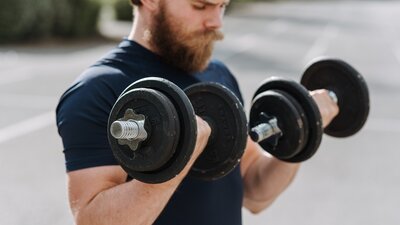If you have hit a plateau with your hypertrophy goals, you most likely need to switch up your training program. You can do this either by challenging your muscles more, improving your lifting technique, or implementing more recovery protocols, such as rest days, protein supplementation, or more sleep.
The Science Behind Muscle Growth
The biggest driver of hypertrophy is simply muscular damage through resistance training. There are three main components to hypertrophy training: progressive overload, mechanical tension, and metabolic stress (1).
Progressive overload is the process of increasing the total volume of work you place on the muscle over time. The general principle of progressive overload in terms of hypertrophy is to fatigue your muscles through increasing amounts of volume at submaximal load (2). One study examined whether you should progressively overload with increased volume or weight. Group A performed the same number of reps but increased the weight each week, which resulted in more strength gains. Group B performed more reps each week but kept the load the same, which resulted in more muscle growth (2). Both progressions are viable strategies for enhancing muscular adaptations depending on your overall goals.
Mechanical tension is also an important stimulus for muscle growth. Mechanical tension refers to the time, load, and motion that a muscle has to work during a certain exercise. Heavier weights, longer duration, and longer range of motion will all increase mechanical tension, which will lead to additional hypertrophy (3).
Metabolic stress is the accumulation of metabolites in the muscles, such as lactate, phosphate, and hydrogen ions, causing a cascade of effects, such as cell swelling, increased blood flow, and production of anabolic hormones (4). You can increase metabolic stress by increasing sets, reps, or weight and/or by shortening rest periods (4). One study found that hypertrophy training program with four sets of 10 reps at 70% 1RM with strict 90 second rest interval induced more lactate and a greater reduction in pH than performing a strength training program with four sets of six reps at 85% 1RM with five minute rest intervals (5).
According to a systematic review of the scientific literature, maximum muscle growth for hypertrophy-oriented resistance training should consist of three to six sets of six to twelve repetitions with 60 second rest intervals at 60−80% of your 1 rep max weight and weekly increases of volume each week (6).
How to Challenge Your Muscles More
Many people focus on the bigger muscle groups, such as chest, back, and legs, leaving their arm training as an afterthought. Other people will do their arm exercises at the end of the workout when they have little mental or physical energy left. Your body will grow based on how you prioritize your training. Perhaps take a rest day before hitting arms, or dedicate a full day or two to arm exercises. If you wanted to go even more extreme, you could train shoulder, triceps, and biceps on separate days to ensure that you are getting maximal hypertrophy.
If you are a person who exclusively does isolation exercises, you may want to incorporate a strength cycle with heavy compound lifts to boost your overall strength, that will in turn boost your strength in isolation exercises. High resistance strength programs like Starting Strength, 5x5, or Wendler 5/3/1 have been shown to increase strength more than low resistance programs (7). This progression will increase your absolute strength, allowing you to lift more submaximal weight when returning to your normal hypertrophy program. Simply adding barbell, smith machine, or hammer strength chest presses can greatly enhance your overall strength in your shoulders and triceps. Adding weighted pull-ups and barbell rows can likewise increase your biceps strength.
If you are an individual who feels strong with compound lifts but doesn’t have well proportioned arms to match, then you may want to try higher volume isolation exercises with submaximal loads. This will allow you to reestablish your mind-muscle connection and ensure that you are not overusing other muscles.
Without a strong enough mind-muscle connection on the bicep curl, many lifters will get more shoulder, traps, and pecs activation, since they must recruit stabilizer muscles when under heavier loads. If you feel your shoulders taking over the exercise, try using an arm blaster device, or simply tuck your arms into your sides to deemphasize the shoulders. You could also try concentration curls, preacher curls, or spider curls to relieve the strain on your anterior delt. If you are getting too much trap activation, try leaning against a wall or bench to prevent unwanted momentum and lessen the workload of your traps. If you are feeling your chest muscles during bicep curls, most likely your shoulders are too internally rotated, which forces your chest to stabilize the weight. Try incline bench bicep curls or wide grip EZ bar curls to help externally rotate your shoulders and activate more of your biceps.
Improving your Form
The key to good form is to perform an exercise with full range of motion with an appropriate weight with the least amount of shearing force on your ligaments, tendons, and joints.
Almost everybody has been guilty of shortening the range of motion during an exercise in order to lift a little more weight at one time or another. This can be an appropriate technique when trying to finish a set or increase metabolic stress. However, it is much more beneficial for strength and hypertrophy gains to train at the extreme end range of motion. This is especially true when training arms, because the movements in bicep flexion, tricep extension, and shoulder exercises are already short movements. The fully lengthened and fully shortened positions are where the mechanical tension is the greatest (8). This systematic review concluded that isometric training at longer muscle lengths elicited greater increases in muscle size compared with isometric training at shorter lengths (9).
However, you should always be cautious of your individual limits on joint range of motion and resistance load at those fully lengthened and shortened positions. The most common upper extremity injuries in resistance training include muscle strains, ligament sprains, pectoralis major tendon ruptures, distal biceps tendon ruptures, and chronic shoulder capsule pain. While injury is always a risk, it is preventable with proper exercise technique, safety, and maintenance of muscle balance (10).
One more caveat to add is that partial range of motion can be very beneficial for addressing your weaknesses and imbalances. For example, many lifters have neglected the distal portion (closest to the elbow) of the bicep due to regularly performing low range of motion reps. Therefore, training the first 15 to 30 degrees of elbow flexion, as in a preacher curl, can be very beneficial.
Maximizing Muscle Growth with Food, Sleep, and Recovery
Hypertrophy depends on a positive muscle protein balance. If you are not consuming enough protein, not getting adequate sleep, and not allowing your body to recover, then your muscular breakdown will exceed your muscle growth (4).
You need a protein surplus in order to prevent muscular breakdown and promote muscular growth. If you are not seeing muscle growth, make sure you are eating enough protein. It is recommended that you eat around 20 grams of protein per meal for four to five feedings for maximal protein synthesis. The 2015 Moore et al study found that the optimal protein consumption is 0.4g per kg (0.18g per lb) of body weight per meal with four servings throughout the day (11). Example: If you weigh 77 kilograms / 170 pounds, you would need around 31g of protein per meal or 124g per day.
Sleep is essential for muscle maintenance and growth (12). Insufficient sleep has been shown to increase body fat and prevent lean muscle mass maintenance (13). One study demonstrated that one night of insufficient sleep causes cellular disruption in circadian rhythms, protein synthesis, and hormone expression (14)(15). Ideally, you should get 7-9 hours of uninterrupted sleep for maximal exercise performance (16). For more information check out: https://www.bodybuilding.com/content/the-importance-of-sleep.html.
Recovery is an often neglected aspect to training and muscle growth. To optimize your muscle recovery after a workout, you should incorporate biological, mechanical, nutritional, and pharmacological strategies for muscle growth (17). You can use heat therapy to promote anabolic growth hormones after a workout (18). You can foam roll, stretch, or mobilize your muscles to help elongate them, which can help build muscle mass and aid in the recovery process (19). Eating more protein and carbohydrates after your workout can help boost your insulin, replenish glycogen levels, and may even contribute directly to muscle growth (20). Lastly, supplements such as Glutamine can greatly help increase your recovery and overall muscle growth (21).
Works Cited
https://www.ncbi.nlm.nih.gov/pmc/articles/PMC5489423/
https://pubmed.ncbi.nlm.nih.gov/19056590/
https://journals.lww.com/acsm-csmr/Fulltext/2017/11000/SleepandAthletic_Performance.11.aspx#R6-11
https://pubmed.ncbi.nlm.nih.gov/29470824/
https://jissn.biomedcentral.com/articles/10.1186/1550-2783-10-42

